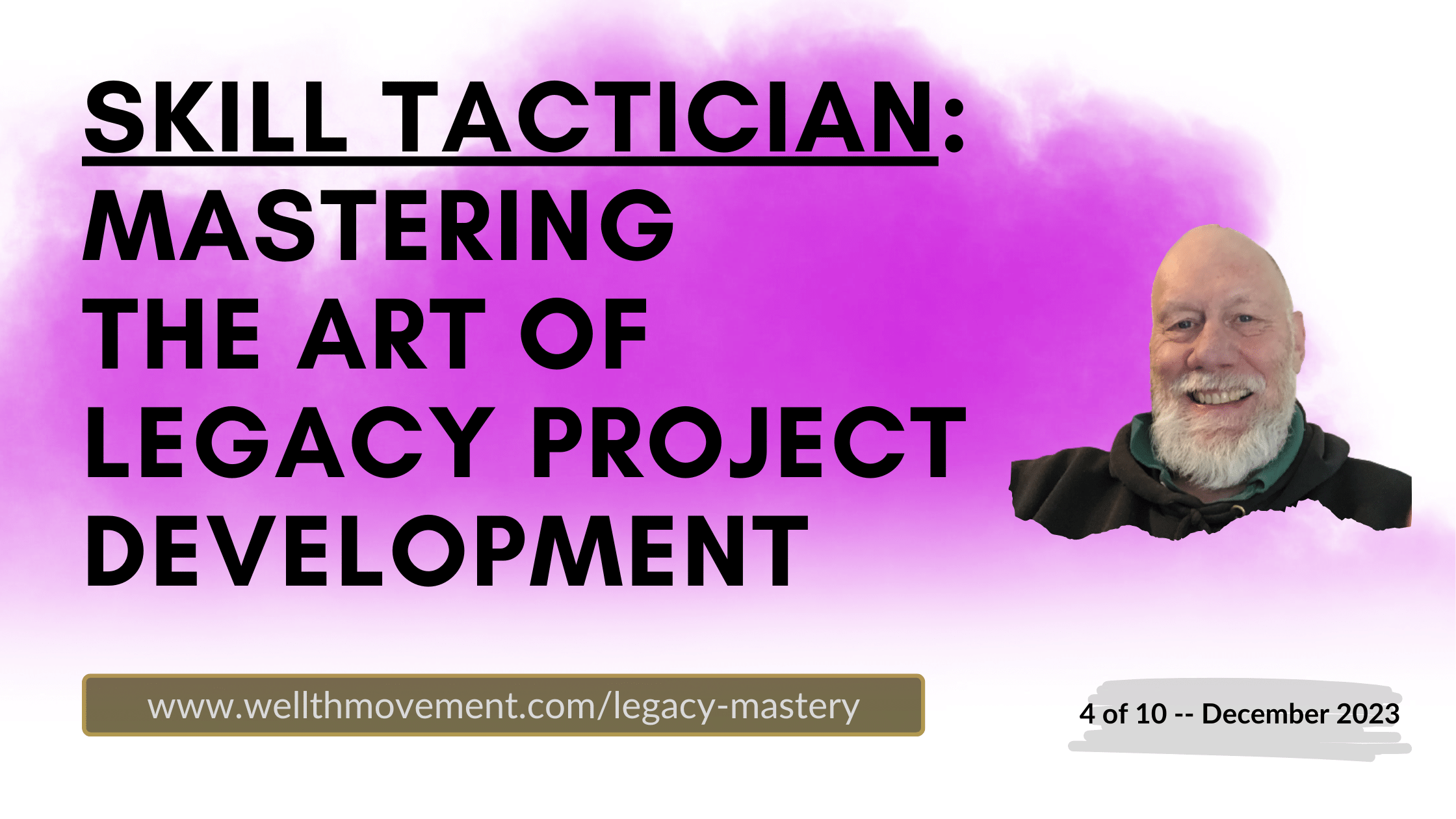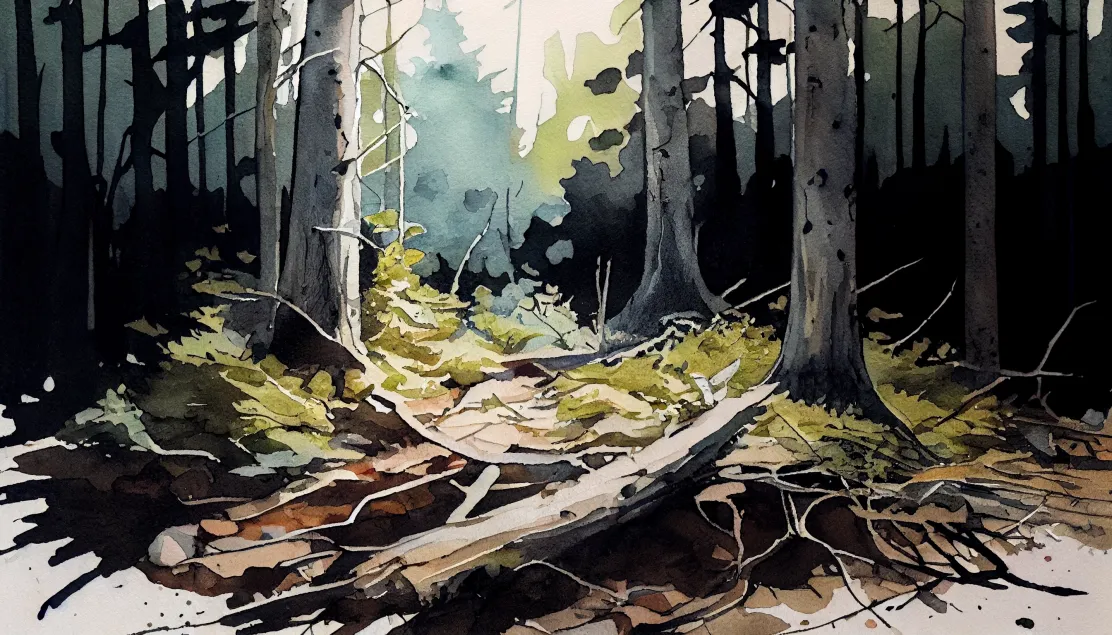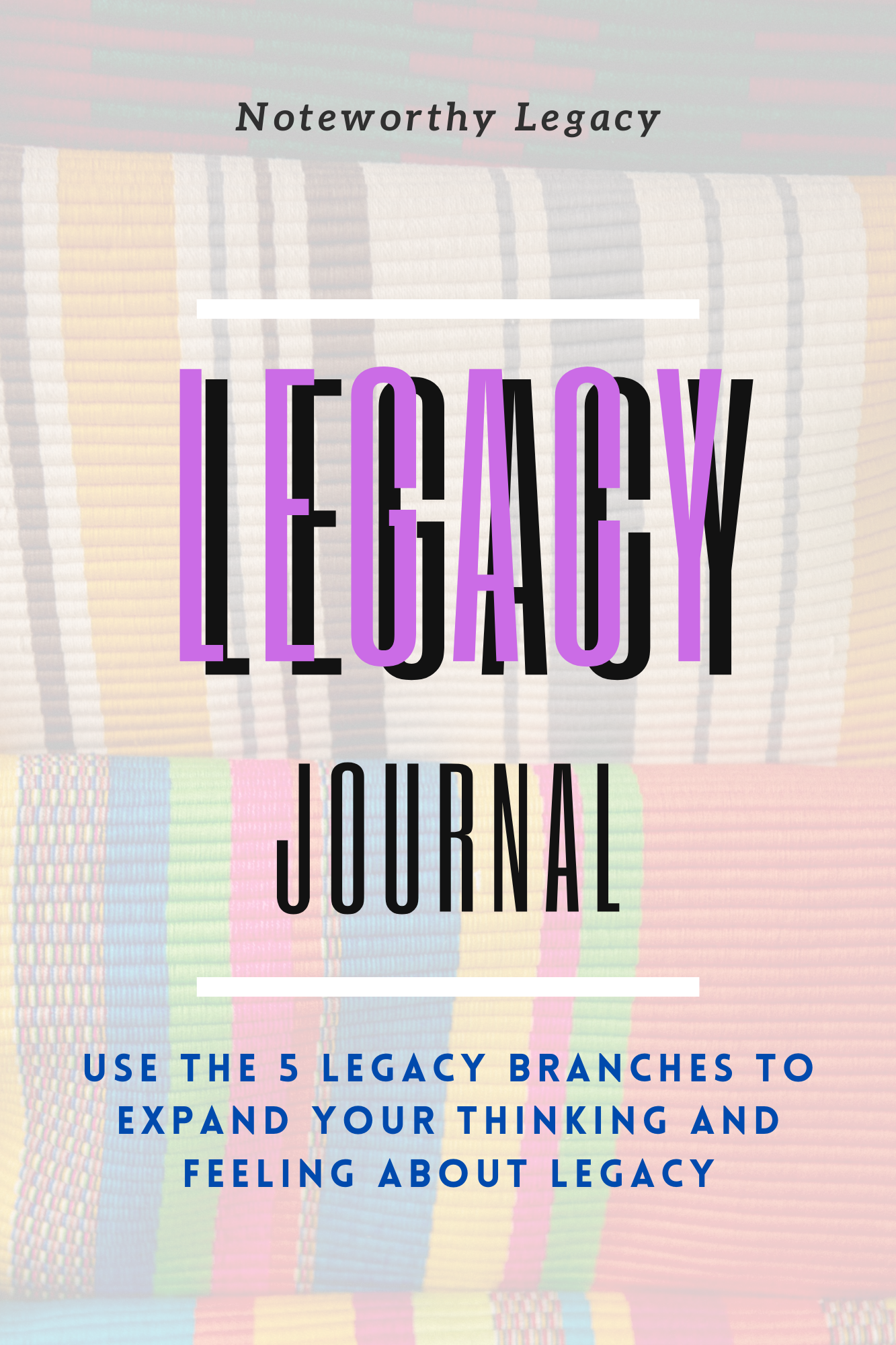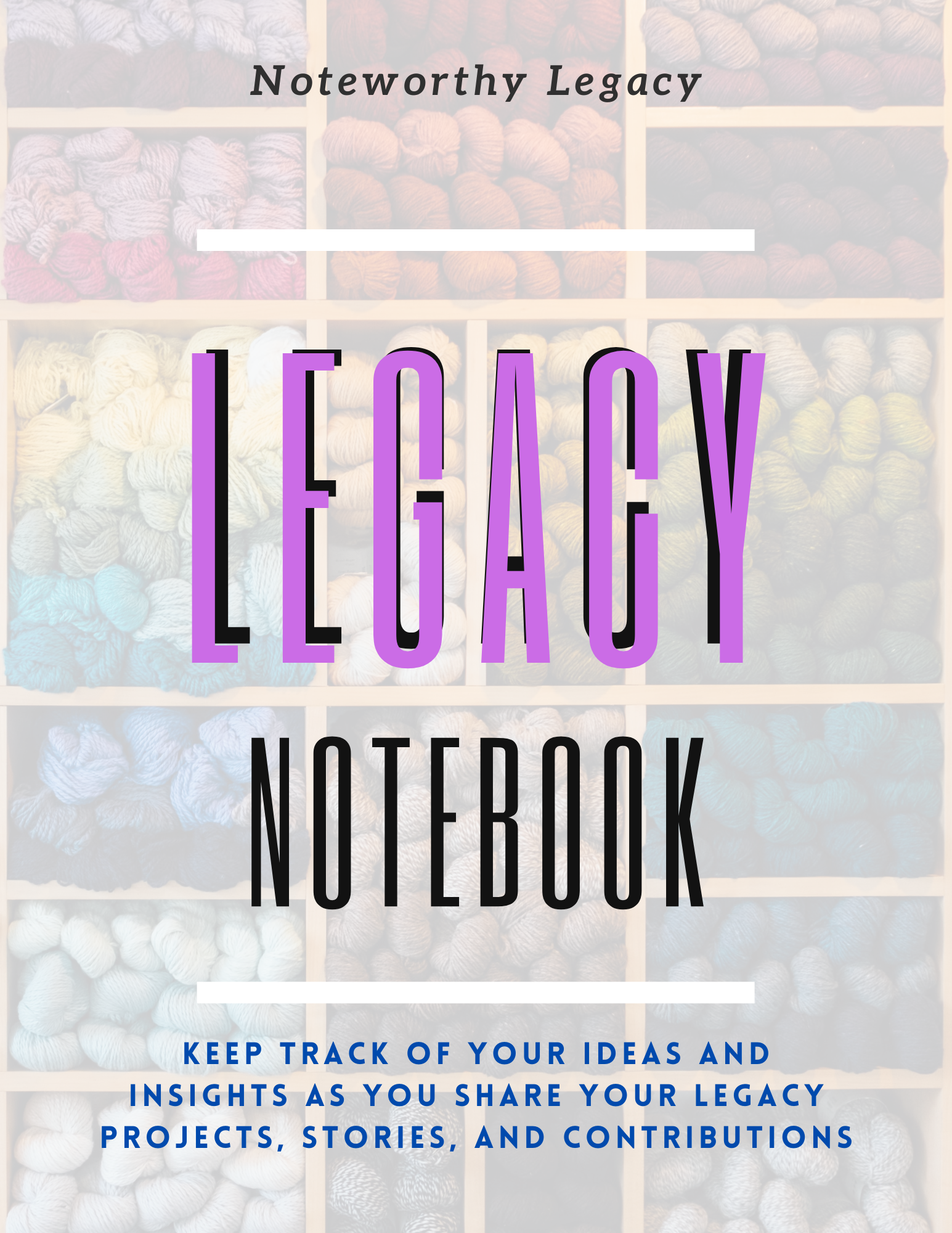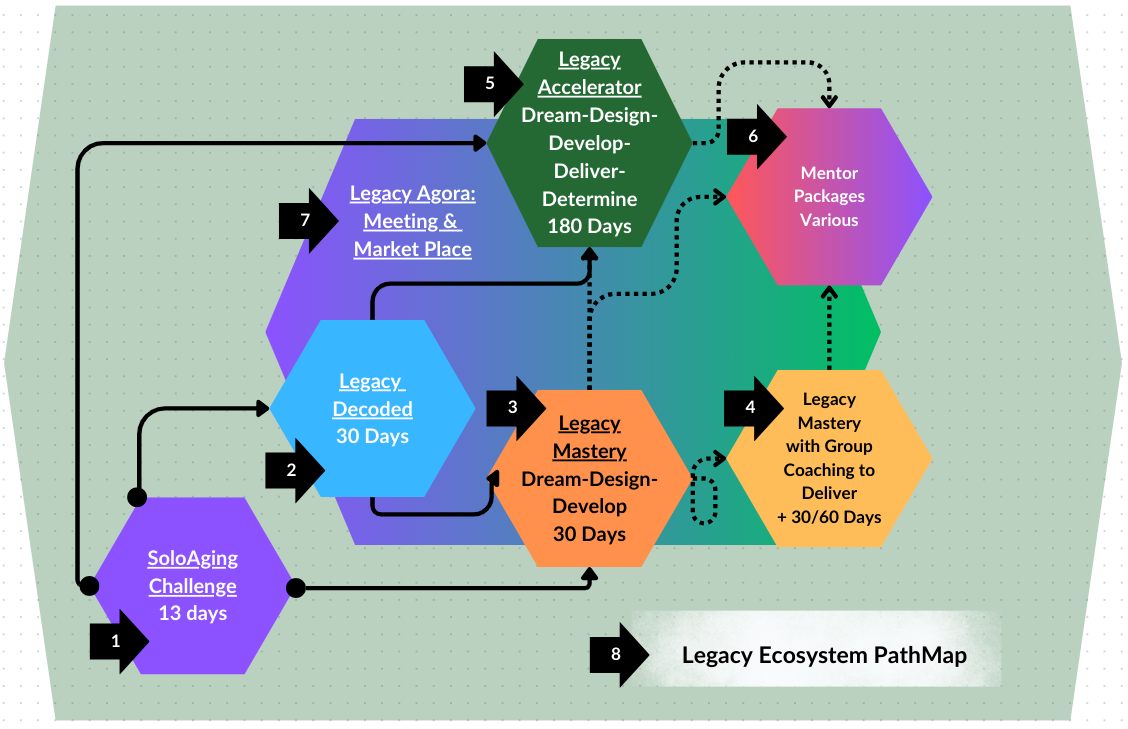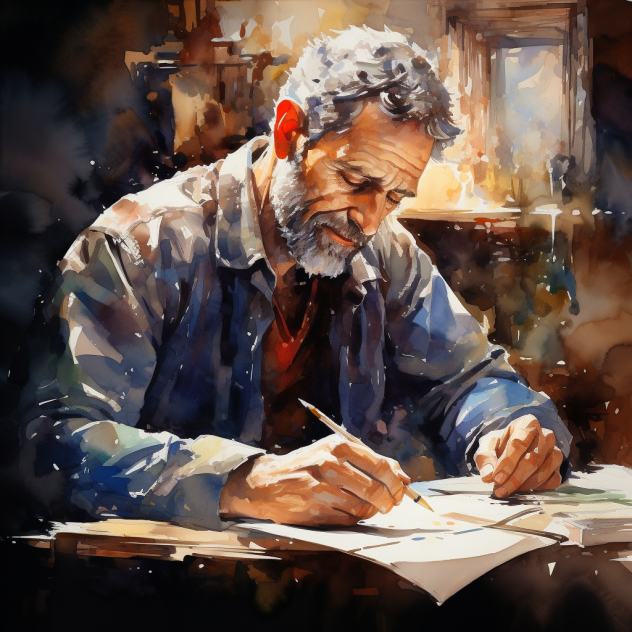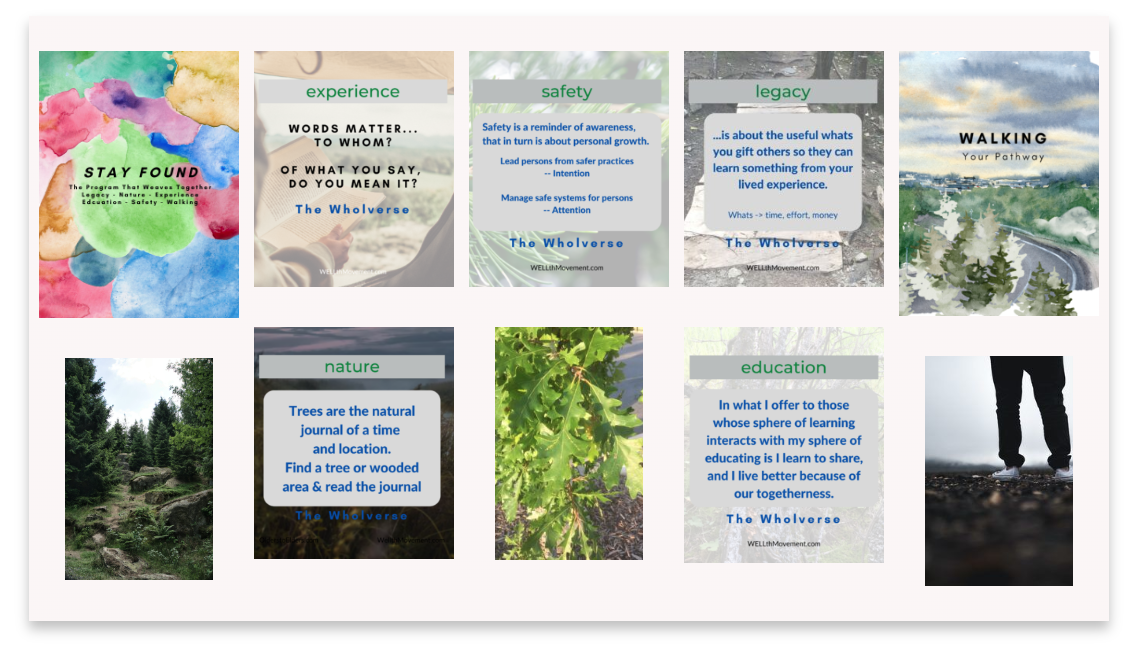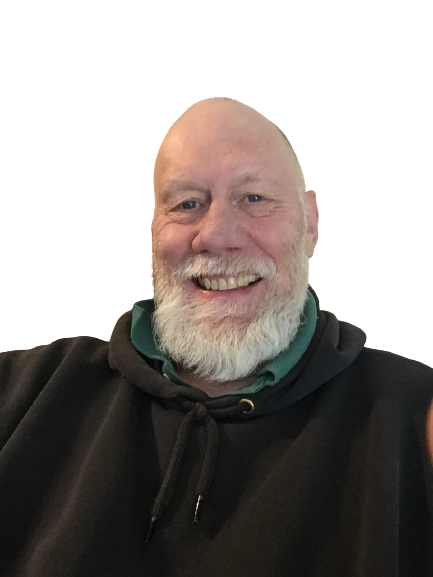Audience: Those shaping and sharing (while living and leaving) a legacy project (with its stories & contributions) for the world and/or with the planet like… Agers - SoloAgers - Empty Nesters - Continuing Educators - Professionals - Retired Creators - Olders as Elders - Grandparents - Intergenerational Contributors - and YOU!
Walking In
Discovering, shaping, and sharing a living legacy project is a profound endeavor, requiring a collaborative and integrative approach to skill development and resource allocation.
The initial content of this article focuses on a general perspective of large-scale project development involving many persons as contributors (staff and volunteers) and recipients. Afterwards, I highlight writing a memoir–as legacy project–for family and friends and/or to serve as a guest on podcasts.
As a Skill Tactician the critical nuances of activities, behaviors, and consequences include:
- recognizing, identifying, and cultivating the strategic/tactical/operational skills (wise practices) necessary for successful project development
- determining the essential resources to support skill development in alignment with legacy project development
There are more project development activities - those here are ilustrative and yet profounding important for those setting up a project.
As a starting point (or for reasons of refocusing) here are three Key Questions:
What Strategic-Tactical Skills Are Required for Project Development?
Why is it Important to Identify Resources for Your Project?
How Can You Develop Skills and Obtain Resources for Your Legacy Project?
In response to the first question:
Q1: What Strategic Skills Are Required for Project Development?
A1: Highlighting Action-Outcomes for the Overall Work Profile Before Delegation
This list is a great starting place…
identify the strategic skills vital for effective project development
identify the tactical skills vital for effective project development
challenge the misconception of underestimating the importance of these skills
discuss the pivotal role of skill development in shaping a successful living legacy
manage internal/external communication requirements using a wholistic safety lens
demonstrate issue identification and initiative planning
foster adeptability (how to adopt and adapt) for each situation
discuss the fundamentals for navigating the complexities of legacy project development
discuss the ways and means to navigate the legacy project development
discuss resource allocations for legacy project development from delivery management
explain (describe) the financial requirements for the project development
explain (describe) the technological requirements for the project development
explain (describe) the staffing requirements for the project development
create a strategy to gain necessary skills
create a strategy to access necessary resources
manage collaboration
manage integration
As to
Q2: Why is it Important to Identify Resources for Your Legacy Project?
A2: Highlighting Three Important Reasons with a Key Reminder
- Ensure the project's sustainability. Adequate resources, whether financial, human, or material, provide the foundation needed to bring your vision to life.
- Streamline the project's development via efficient planning and allocation of tasks to ensure that you have the support to overcome challenges and achieve your objectives.
- Enable navigation of potential obstacles, maintain momentum, and create a more impactful and lasting legacy.
Remember: Resource identification and allocation is the backbone of a well-executed and meaningful project.
As to
Q3: How Can You Develop Skills and Obtain Resources for Your Legacy Project?
A3: Highlighting 5 Ways to Develop Skills and Obtain Resources
_ Collaborate with experts:
___Form partnerships or collaborate with individuals who possess the skills and resources you lack. Leverage (hire) their expertise to enhance your own and jointly contribute to the success of your legacy project.
__Attend relevant workshops:
___Enroll in workshops, courses, or events related to your legacy project's objectives. This not only allows you to acquire new skills but also provides networking opportunities to connect with potential mentors, collaborators, or supporters.
_ Seek grants and sponsorships:
___Explore funding options through grants, sponsorships, or crowdfunding. Securing financial resources can enable you to invest in skill development programs, hire experts, or gain necessary tools and materials for your legacy project.
_ Volunteer or intern:
___Gain hands-on experience by volunteering or interning in fields related to your legacy project. This not only helps you develop practical skills but also expands your network and opens doors to potential mentors or collaborators.
_ Leverage online platforms:
___Utilize online platforms, such as e-learning websites, forums, and social media groups, to access resources and connect with professionals in your field. Online communities can provide valuable insights, advice, and learning opportunities for your skill development journey.
The insights shared to this point highlight Skill Tactician requirements for skill development and obtaining resources for a large scale legacy project. This content is not exhaustive - more so, illustrative to identify the importance of project development for project management.
Often, one of the weak links in the project lifecycle is when persons give a cursory review of project development (especially skill development and resource allocation) because they want to get to project delivery. Unfortunately, in delivery, they find their errors and return to project development repeatedly until they get it correct. An added caveat, development and delivery are two sides of the same coin.
Broad Activity Categories for Project Development within the larger context of Project Management
*
Confirm from
Project Design
Define the project's purpose and objectives.
Identify stakeholders and their roles.
Develop a project movefesto.
Not in order:
Planning:
Create a comprehensive project plan outlining tasks and timelines.
Define project scope, budget, and resources.
Establish risk management and mitigation strategies.
Execution:
Implement the project plan and carry out the defined activities.
Coordinate people and resources.
Address and resolve issues in real-time.
Monitoring and Controlling:
Track project progress against the plan.
Monitor and control project risks.
Ensure quality standards are met.
Closing:
Confirm that all project deliverables are complete.
Obtain formal acceptance from stakeholders.
Evaluate project success and lessons learned.
Communication:
Establish a communication plan.
Regularly update stakeholders on progress.
Facilitate collaboration and integration among group/team members.
Risk Management:
Identify potential risks.
Assess the impact and probability of each risk.
Develop strategies to mitigate or respond to risks.
* Resource Management:
Allocate resources effectively.
Monitor resource utilization.
Anticipate and address resource constraints.
Quality Management:
Define quality standards.
Implement quality control measures.
Ensure that deliverables meet predefined quality criteria.
Change/Transition Management:
Establish a transition process for handling changes.
Assess the impact of change/transition on the project.
Communicate updates to relevant stakeholders.
* Group/Team Collaboration:
Ensure knowledge and skill development by accountability profile.
Foster a collaborative group/team environment.
Address conflicts using feed-forward techniques.
When The Project is Smaller - Like Writing a Memoir
Here are 11 action-outcome statements for which skill development (e.g., how to write) and resource allocation (e.g., where to write, how to access research) are important for developing your writing project.
- Draft the Outline:
Craft a structured outline sets the foundation, ensuring your memoir unfolds seamlessly, capturing the essence of your life's journey. - Chronicle Life Chapters:
Reorganize your memories into captivating chapters, each telling a unique aspect of your personal narrative with depth and authenticity. - Infuse Emotional Resonance:
Add emotions authentically creating an interesting connection, allowing readers to experience the highs and lows of your life alongside you. - Craft Vivid Descriptions:
Use descriptive language to paint a vivid picture of settings, characters, and experiences, immersing readers in your life happenings.
_To this point, it’s more about Information; Now, move into Transformation - Reveal Personal Growth:
Share the transformative moments and lessons that shaped you, demonstrating personal growth and resilience throughout your life. - Engage Dialogue Effectively:
Convey conversations with authenticity, ensuring dialogue enhances the narrative and reflects the personalities of those who have influenced your journey. - Balance Reflection and Action:
Integrate reflective moments with dynamic action, providing readers with insights while maintaining a sense of momentum in your memoir. - Capture Milestones:
Highlight significant life events and milestones, allowing readers to celebrate achievements and understand the impact of key moments on your legacy.
_Here while you are still sharing Transformation insights; Now, include insights about the ways and means of reshaping-reframing-reinventing yourself. - Explore Themes:
Identify overarching themes in your life story, such as resilience, love, or self-discovery, weaving them throughout your memoir for a cohesive narrative sharing how they inform-transform who you are becoming today. - Incorporate Personal Wisdom:
Share your unique point of view on life, offering personal insights, philosophies, and wisdom gained from your experiences in the words of your potential readers. - Reflection In and On Experiences:
Summarize your reflective thoughts, leaving readers with a sense of continuance (or closure depending on your life status) and inspiration.
___ Consider your answers to the questions: So What? What Else? Now What?
With these actions, you are completing your writing project development. Now you can start writing and sharing while editing (adding, altering, deleting insights from your development stage).
Moving Forward:
The ultimate outcome of the Skill Tactician step is to identify the strategic-tactical skills and resources essential for your living legacy project development.
It's obligatory to have a clear pathmap for personal and/or professional development. In doing so, you ensure your journey towards crafting a meaningful living legacy project leverages your strategic/tactical capabilities (or from those you involve) and well-informed resource allocation is in place using safe system/safer practices lenses.
AND, it’s important to up-level your "development" knowledge and skills (the concepts and practices) as you move to legacy project delivery.
Starting the interview process for a cohort Legacy Mastery course starting in January 2024.
9 8 Seats available at time of posting this article!
Personal Reflection:
In a world often characterized by laborious planning, the ignorance of key project elements, and unclear project framing, through the Legacy Mastery Program (Course and Mentoring) you become the master of your legacy and legacy project.
- You do not need project management experience - you have some of it, we can fill in the blanks!
- You do not need marketing experience - yet you experience it everyday!
- You do not need considerable financial resources - could be helpful.
Yet, most projects are about time and effort!
What you require–is being ready, able, and willing
- to clarify your legacy project pathway with confidence and commitment
- to connect and complete a “section//element of your selected project (beta test)”
- to confirm a green light to move forward with the whole project
Please
share - TU!
_/|_ Visit the store - there are books for sale like:
Visit the Store to access
support resources:
_/|_ Click to access the Wellth Blog.
_/|_ Watch YouTube videos here:
WellthLearningTV - main channel for all things soloaging and legacy
Awarests - main channel for all things nature awareness and trees & forests
Mentoring Community - main channel for mentoring practices
How We Stay Connected
If you want to receive updates - no more than 5 a month, that's one a week
- add your first name and email to the form below (as indicated by the red asterisks).
AND, by filling in all or portions of the form --- OPTIONAL
--> "you help us to help you" with what we can offer to move you forward.
For example:
- On the New Moon and Full Moon dates, you'll receive a summary of the blog posts, video links, and image content (so you can binge watch and read!) = 2X per month
- Learn about upcoming special deals and first notice alerts with discounts! = 1X per month
- Receive updates on times we meet online to answer questions you send us! = 1-2X per month
Along the journey as you weave your tapestry, paint your canvas, write in your journal
understanding StoryScope and Legacy are important concepts and practices.
A quick reminder of both follow:
Understanding the StoryScope
Our lives are stories waiting to be told, narratives that unfold with each passing day.
The metaphor of "StoryScope" invites us to view this narrative through different lenses. Just as telescopes reveal the vastness of the universe, microscopes uncover the intricacies of the microscopic world, stethoscopes listen to our vital sounds of living, our StoryScope allows us to explore and find the full spectrum of our daily existence.
Our daily lives resemble a kaleidoscope, with each decision, action, and interaction contributing to the ever-shifting, meaningful pattern.
As SoloAgers and seasoned professionals, you have a unique perspective on life's twists and turns. Your legacy is not only a reflection of your past-present but a blueprint for the future-present.
Legacy: The Useful Whats
Legacy is often associated with material wealth, but it extends far beyond possessions. Legacy comprises the "useful whats" we leave behind, including our time, effort, and money. These elements are the building blocks and seedbeds of our legacy, and how we allocate, plant them shapes the stories we share.
For Agers, especially SoloAgers (and Olders to Elders), who have accumulated a wealth-wellth of experiences and knowledge, legacy is about passing on wisdom and lessons. Your is about preserving your story as it is about empowering others to write their chapters more skillfully. As professionals and educators, your legacy resides in the work you shared, the values you instilled, and the innovations you sparked.
Guide to Programming through WELLth Movement
for Aging, especially SoloAging: Professionals and ParaProfessionals
Below, if the numbered title is bold blue, it is ACTIVE!
Here you can click access more information and the investment buttons.
The non-Active buttons are coming on line before the end of 2023!
If you have a Question and/or Comment
about one or more of the Programs and Projects
in the Legacy Agora EcoSystem and/or the PathMap,
please use this form. TU!
PS: The System and Maps are subject to Edits.
Transparency: AI-assisted based on priming and prompting! Considerable editing followed.
Please
share - TU!
It's all about sharing the legacy you intend to live (and leave).
For more in-depth insights about:
INVITE Soloaging Olders to be Elders
who discover, shape, and share the legacy
they intend to live and leave Start here
Certification as a mentor Start here
To contact us use our Contact Page
Add your comments - update the insights in your words
- share funnies for all of us to read below the blog list!
Audience: Olders to Elders - SoloAgers - Empty Nesters - Continuing Educators - Professionals -
Audience: Olders to Elders - SoloAgers - Empty Nesters - Continuing Educators - Professionals -
Audience: Olders to Elders - SoloAgers - Empty Nesters - Continuing Educators - Professionals -
Audience: Olders to Elders - SoloAgers - Empty Nesters - Continuing Educators - Professionals -
Audience: Olders to Elders - SoloAgers - Empty Nesters - Continuing Educators - Professionals -
Audience: Olders to Elders - SoloAgers - Empty Nesters - Continuing Educators - Professionals -
